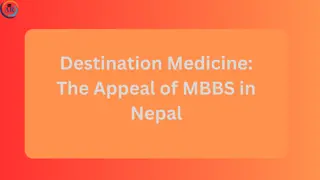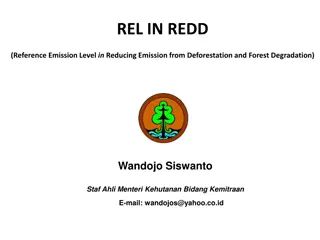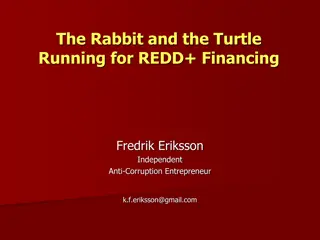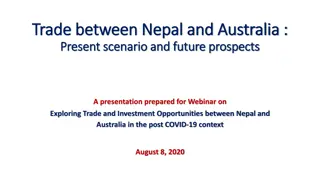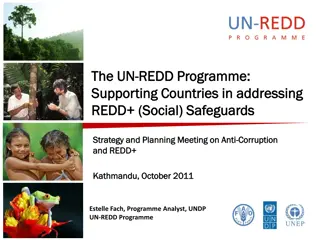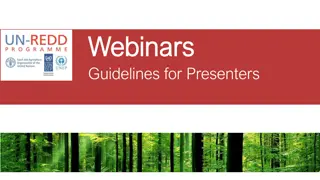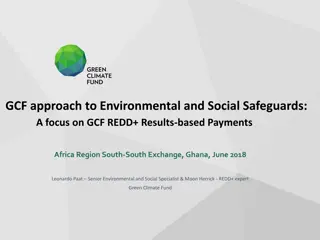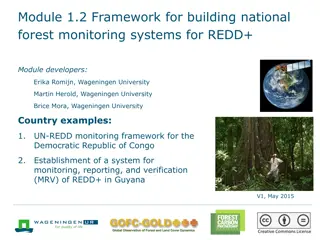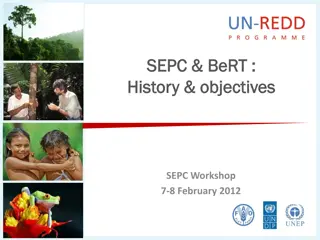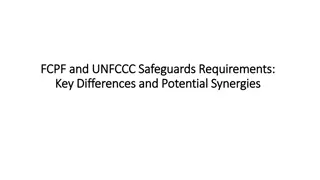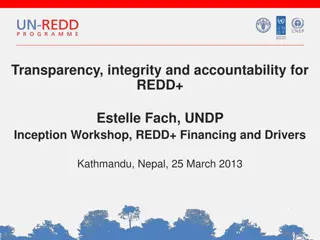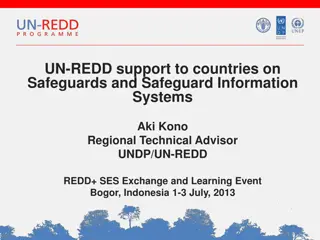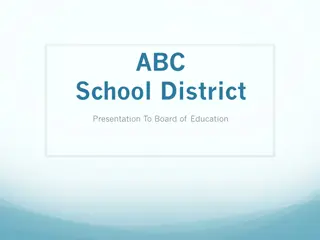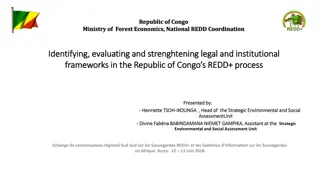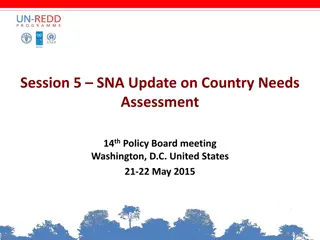Options for REDD+ Fund Management System in Nepal
Assessing options for an effective, efficient, and equitable fund management system for REDD+ finance in Nepal is crucial as the program moves into the implementation phase. This assessment focuses on identifying and evaluating potential financing mechanisms for REDD+ in Nepal, considering various factors such as market compliance, private fund flow, national fund management, drivers of deforestation, and involvement of local and public actors. The methodology involves reviewing existing fund flow mechanisms, national development programs, international REDD+ practices, key consultations, and local interactions to propose suitable options for REDD+ financing. Additionally, the study reviews relevant national financing schemes to inform the assessment process.
Download Presentation

Please find below an Image/Link to download the presentation.
The content on the website is provided AS IS for your information and personal use only. It may not be sold, licensed, or shared on other websites without obtaining consent from the author.If you encounter any issues during the download, it is possible that the publisher has removed the file from their server.
You are allowed to download the files provided on this website for personal or commercial use, subject to the condition that they are used lawfully. All files are the property of their respective owners.
The content on the website is provided AS IS for your information and personal use only. It may not be sold, licensed, or shared on other websites without obtaining consent from the author.
E N D
Presentation Transcript
Assessing options for the design of an effective, efficient and equitable fund management system for REDD+ finance in Nepal Rajesh Rai
Outline Background, Objectives, Scope, Methodology, Framework, Key issues, Preliminary findings,
Background REDD+ is in piloting phase, Volume of REDD+ finance increases in future when the program comes into the implementation phase, A country may receive funds from various sources market and non-market, Effective , efficient & equitable distribution of REDD+ funds contributes to harmonize benefits distribution, addressing drivers of forest resource depletion and creating country ownership,
Objectives To identify and assess the potential options for REDD+ financing mechanism in Nepal, Suggest potential options for REDD+ financing considering possible fluctuations in the carbon price,
Scope of the study Market (complian ce & voluntary) Private (Foundations / Charitable, Corporate social responsibility ) Fund flow Nation al Level (Fund Manageme nt) Drivers of Deforestation / Forest degradation Local Actors Public (Bilateral initiatives, Global Fund, National Fund)
Methodology Review of public fund flow mechanisms, National level development and conservation programs, REDD+ piloting in Nepal, REDD+ international practices, Key person consultations (tax, fiscal policies, natural resources management and REDD+), Local level interactions and Focus group discussions,
Review of some national financing schemes Local Governance and Community Development Program (LGCDP), Poverty Alleviation Fund (PAF), The Nepal Peace Funds (NPF), The School Sector Reform Program (SSRP), The Alternative Energy Promotion Center (AEPC), Nepal Disaster Risk Reduction Consortium (NRRC), National Trust for Nature Conservation (NTNC), Buffer Zone Management Fund (BZMF),
Framework UN-REDD+ Corruption Risk Assessment Methodology, Effective, Efficient and Equitable fund flow mechanism, Avoidance of misrepresentation and misappropriation of financial flows
Key issues Basis of rewarding the forest managers Output/result base (carbon stock, biodiversity conservation) Input (labour, financial resources) Opportunity costs (changing livelihood activities), Monitoring cost,
Key issues (contd.) Institutional Modality Project based, Separate trust funds, Funds managed by the government, Budgetary support, On budget /Off budget The size of REDD+ fund,
Framework for assessing the REDD+ financing modalities Adopted from Angelsen et al. 2009, and Vetn and Vedeld 2011 Criteria Project based Trust funds Separate funds managed under the government (+) leakage and permanence issues can be addressed (+) Fairly good on sector coordination (-) Attraction of private funding depends on international regime (-) Issues on additionality (+) Low transaction costs Budgetary support Effecti veness (+) attract private funding (-) leakage, additionality, permanence and coordination (+) attract public funding (+) Fairly strong on leakage (+) Fairly good on permanence (-) additionality (-) weak coordination (+) Rather strong on leakage (+) Strong on sector coordination (+) Permanence can be gained with high state commitment (-) difficult to attract private funding (-) Additionality Efficie ncy (+) Cost-efficient REDD+ investment (+) Fairly good capacity to keep transaction costs down (+) Good potential to keep transaction costs down (-) High transaction costs Issues concerning most low cost REDD+ options Equity (-)Intermediaries capture REDD+ rents (-) Elite capture at local level (-) Elite capture (+) Equity can be gained by strong state commitment (-) funds used for other purposes than REDD+ (-)Elite capture at all levels
Preliminary findings from review of national development and conservation initiatives MOE adopts (SSRP) one door only policy for development partner interaction ensures sufficient fund and equitable distribution across the districts. GoN and donors have developed a Joint Financing Arrangement (JFA), Governance and Accountability Action plan of PAF & SSRP identifies corporate governance, coordination and cooperation between program and government agencies. Minister of Environment chairs AEPC governing board and representatives from other line ministries, industry and NGOs, which is a good practice of multi stakeholder approach.
Findings cont.. Performance based grant disbursement modality adopted by LGCDP helps to encourage implementing agents and also facilitates equitable distribution of funds. SSRP manages direct funding and technical assistance, which is not a part of the Red Book program, through Joint Steering Committee. PAF practices outcome based reporting system and also carries out project impact assessment, and manages management information system, Social auditing system practices by LGCDP, PAF and SSRP enhances public ownership, transparency and involvement of beneficiaries.

 undefined
undefined







